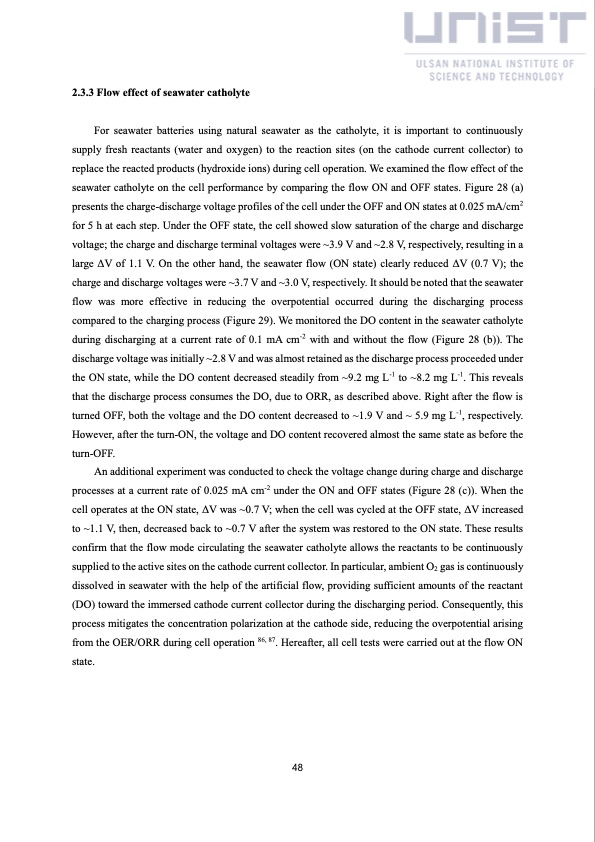
PDF Publication Title:
Text from PDF Page: 053
2.3.3 Flow effect of seawater catholyte For seawater batteries using natural seawater as the catholyte, it is important to continuously supply fresh reactants (water and oxygen) to the reaction sites (on the cathode current collector) to replace the reacted products (hydroxide ions) during cell operation. We examined the flow effect of the seawater catholyte on the cell performance by comparing the flow ON and OFF states. Figure 28 (a) presents the charge-discharge voltage profiles of the cell under the OFF and ON states at 0.025 mA/cm2 for 5 h at each step. Under the OFF state, the cell showed slow saturation of the charge and discharge voltage; the charge and discharge terminal voltages were ~3.9 V and ~2.8 V, respectively, resulting in a large ΔV of 1.1 V. On the other hand, the seawater flow (ON state) clearly reduced ΔV (0.7 V); the charge and discharge voltages were ~3.7 V and ~3.0 V, respectively. It should be noted that the seawater flow was more effective in reducing the overpotential occurred during the discharging process compared to the charging process (Figure 29). We monitored the DO content in the seawater catholyte during discharging at a current rate of 0.1 mA cm-2 with and without the flow (Figure 28 (b)). The discharge voltage was initially ~2.8 V and was almost retained as the discharge process proceeded under the ON state, while the DO content decreased steadily from ~9.2 mg L-1 to ~8.2 mg L-1. This reveals that the discharge process consumes the DO, due to ORR, as described above. Right after the flow is turned OFF, both the voltage and the DO content decreased to ~1.9 V and ~ 5.9 mg L-1, respectively. However, after the turn-ON, the voltage and DO content recovered almost the same state as before the turn-OFF. An additional experiment was conducted to check the voltage change during charge and discharge processes at a current rate of 0.025 mA cm-2 under the ON and OFF states (Figure 28 (c)). When the cell operates at the ON state, ΔV was ~0.7 V; when the cell was cycled at the OFF state, ΔV increased to ~1.1 V, then, decreased back to ~0.7 V after the system was restored to the ON state. These results confirm that the flow mode circulating the seawater catholyte allows the reactants to be continuously supplied to the active sites on the cathode current collector. In particular, ambient O2 gas is continuously dissolved in seawater with the help of the artificial flow, providing sufficient amounts of the reactant (DO) toward the immersed cathode current collector during the discharging period. Consequently, this process mitigates the concentration polarization at the cathode side, reducing the overpotential arising from the OER/ORR during cell operation 86, 87. Hereafter, all cell tests were carried out at the flow ON state. 48PDF Image | China solar seawater battery

PDF Search Title:
China solar seawater batteryOriginal File Name Searched:
solar-seawater.pdfDIY PDF Search: Google It | Yahoo | Bing
Product and Development Focus for Salgenx
Redox Flow Battery Technology: With the advent of the new USA tax credits for producing and selling batteries ($35/kW) we are focussing on a simple flow battery using shipping containers as the modular electrolyte storage units with tax credits up to $140,000 per system. Our main focus is on the salt battery. This battery can be used for both thermal and electrical storage applications. We call it the Cogeneration Battery or Cogen Battery. One project is converting salt (brine) based water conditioners to simultaneously produce power. In addition, there are many opportunities to extract Lithium from brine (salt lakes, groundwater, and producer water).Salt water or brine are huge sources for lithium. Most of the worlds lithium is acquired from a brine source. It's even in seawater in a low concentration. Brine is also a byproduct of huge powerplants, which can now use that as an electrolyte and a huge flow battery (which allows storage at the source).We welcome any business and equipment inquiries, as well as licensing our flow battery manufacturing.| CONTACT TEL: 608-238-6001 Email: greg@salgenx.com | RSS | AMP |